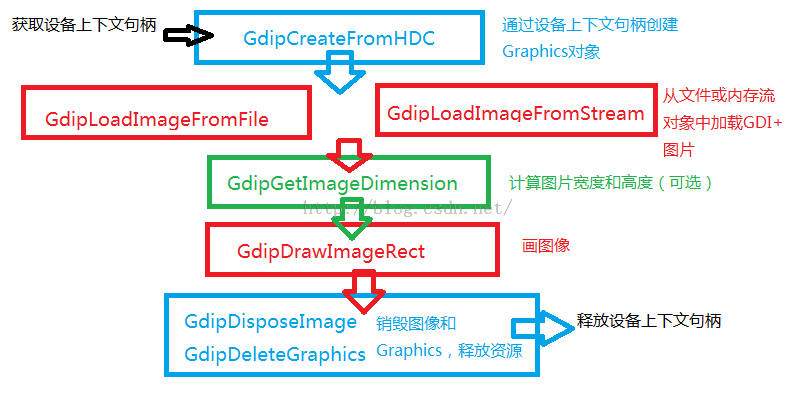GdiplusFlat(5)画图片
在上两篇篇中,我们说到了通过GdipCreateFromHDC函数将HDC(设备上下文句柄)装换成GDI+的Graphics对象,并讲到了画笔和画刷的使用,这一篇就来讲讲如何利用GDI+Flat来画图片。
还是和以前一样,我们必须自己声明GDI+Flat函数,自己定义GDI+Flat的数据结构。自己动手,丰衣足食。~~
对于画图片,其实是GDI+调用的GDI+Flat的这几个函数:GdipLoadImageFromFile、GdipLoadImageFromStream、GdipGetImageDimension、GdipDrawImageRect和GdipDisposeImage
我们把这两个函数自己声明出来!不用那些GDI+类的东西!只用C和Win32的最基本的数据类型!
//画图片 extern "C" int WINAPI GdipLoadImageFromFile(WCHAR* filename, int** image); extern "C" int WINAPI GdipLoadImageFromStream(LPSTREAM stream, int** image); extern "C" int WINAPI GdipGetImageDimension(int* image, float* width, float* height); extern "C" int WINAPI GdipDrawImageRect(int graphics, int* image, float x, float y, float width, float height); extern "C" int WINAPI GdipDisposeImage(int* image);
先不解释这几个函数的具体使用方法,先来看看我们如何通过GDI+Flat画出一张图片。
流程如下:
原谅博主的绘图水平吧,,,
下面具体说说这几个函数的用法
GdipLoadImageFromFile:从文件加载图片对象
参数1:Unicode字符:文件名称
参数2:指向一个Image对象的指针,用于接收返回的Image对象,Image对象是int*
GdipLoadImageFromStream:从内存流中加载图片对象
参数1:内存流对象指针
参数2:指向一个Image对象的指针,用于接收返回的Image对象,Image对象是int*
GdipGetImageDimension:计算图片大小
参数1:一个Image对象
参数2:一个指向float类型变量的指针,用于接收图片宽度
参数3:一个指向float类型变量的指针,用于接收图片高度
GdipDrawImageRect:绘制图片
参数1:要把图片绘制到的Graphics对象
参数2:一个Image对象
参数3,4:图片左上角的坐标,坐标相对于DC的左上角
参数5,6:要绘制的宽度、高度
GdipDisposeImage:销毁Image对象
参数:要销毁的Image对象
以上函数的返回值:0成功,非0失败
关于GdipLoadImageFromStream从内存流中创建Image对象:
使用GlobalAlloc,GlobalLock,GlobalUnlock,CreateStreamOnHGlobal,GlobalFree等函数创建和处理内存流。但是GDI+Flat没有提供可以直接使用RC资源进行绘图的函数,对于这个问题,我想到过两种解决方案:
1.将图片追加写到PE文件(程序自身)的尾部,这样图片就超出了PE结构了,PE文件加载时数据不会装入内存,程序运行时读取自身,把图片读入到内存流中,用GdipLoadImageFromStream创建Image对象。
2.将图片以RC资源的形式写入程序,使用LoadImage函数获取句柄,创建内存场景,在内存设备上下文中用GDI(不是GDI+)绘图,用时再进行DC复制。缺陷:不支持png图片
具体例子(从D:\1.png绘图)
case WM_PAINT: HDC hdc; PAINTSTRUCT ps; hdc = BeginPaint(hwnd, &ps); int graphics; float x, y; GdipCreateFromHDC(hdc, &graphics);//创建Graphics对象 GdipLoadImageFromFile(L"D:\\1.png", &image);//创建Image对象 GdipGetImageDimension(image, &x, &y);//计算图片宽度和高度 GdipDrawImageRect(graphics, image, 20, 20, x, y);//画图片 GdipDisposeImage(image);//销毁图片,释放资源 GdipDeleteGraphics(graphics);//销毁Graphics对象 EndPaint(hwnd, &ps); return 0;//告诉系统,WM_PAINT消息我已经处理了,你那儿凉快哪儿玩去吧。
效果图:
完整源码:
#include "stdafx.h"
#include <gdiplus.h>
#include <gdiplusflat.h>
#pragma comment(lib,"gdiplus.lib")//very important
#include <windows.h>
#include <windowsx.h>
#pragma comment(lib,"user32.lib")
#pragma comment(lib,"gdi32.lib")
//GDI+Flat
typedef struct _GdiplusStartupInput{
unsigned int GdiplusVersion;
unsigned int DebugEventCallback;
BOOL SuppressBackgroundThread;
BOOL SuppressExternalCodecs;
}GdiplusStartupInput;
extern "C" int WINAPI GdiplusStartup(int* token, GdiplusStartupInput *input, int *output);
extern "C" void WINAPI GdiplusShutdown(int token);
extern "C" int WINAPI GdipCreateFromHDC(HDC hdc, int* graphics);
extern "C" int WINAPI GdipDeleteGraphics(int graphics);
//画笔
extern "C" int WINAPI GdipCreatePen1(unsigned int argb_color, float width, int unit, int** pen);
extern "C" int WINAPI GdipDeletePen(int* pen);
//画矩形 画直线
extern "C" int WINAPI GdipDrawRectangle(int graphics, int* pen, float x, float y, float width, float height);
extern "C" int WINAPI GdipDrawLine(int graphics, int* pen, float x1, float y1, float x2, float y2);
//画刷
typedef struct _PointF{
float x;
float y;
}PointF;
extern "C" int WINAPI GdipCreateSolidFill(unsigned int argb_color, int** brush);
extern "C" int WINAPI GdipCreateLineBrush(PointF* point1, PointF* point2, unsigned int argb_color1, unsigned int argb_color2, int wrapMode, int** lineGradient);
extern "C" int WINAPI GdipDeleteBrush(int* brush);
//画填充矩形
extern "C" int WINAPI GdipFillRectangle(int graphics, int* brush, float x, float y, float width, float height);
//画图片
extern "C" int WINAPI GdipLoadImageFromFile(WCHAR* filename, int** image);
extern "C" int WINAPI GdipLoadImageFromStream(LPSTREAM stream, int** image);
extern "C" int WINAPI GdipGetImageDimension(int* image, float* width, float* height);
extern "C" int WINAPI GdipDrawImageRect(int graphics, int* image, float x, float y, float width, float height);
extern "C" int WINAPI GdipDisposeImage(int* image);
int token;
int* pen;
int* brush;
int* linebrush;
int* image;
//*************************************************************
LRESULT CALLBACK WndProc(HWND hwnd, UINT message, WPARAM wParam, LPARAM lParam);
WNDCLASS wc;
const TCHAR* AppName = TEXT("MyWindowClass1");
HWND hwnd1;
int APIENTRY _tWinMain(_In_ HINSTANCE hInstance,
_In_opt_ HINSTANCE hPrevInstance,
_In_ LPTSTR lpCmdLine,
_In_ int nCmdShow)
{
//GDI+开启
GdiplusStartupInput StartupInput = { 0 };
StartupInput.GdiplusVersion = 1;
if (GdiplusStartup(&token, &StartupInput, NULL))MessageBox(0, TEXT("GdiPlus开启失败"), TEXT("错误"), MB_ICONERROR);
//这里是在构建窗口类结构
wc.style = CS_HREDRAW | CS_VREDRAW;
wc.lpfnWndProc = WndProc;//窗口回调函数指针
wc.cbClsExtra = 0;
wc.cbWndExtra = 0;
wc.hInstance = hInstance;//实例句柄
wc.hIcon = LoadIcon(hInstance, TEXT("ICON_1"));
wc.hCursor = LoadCursor(NULL, IDC_ARROW);//默认指针
wc.hbrBackground = (HBRUSH)(COLOR_WINDOW);//默认背景颜色
wc.lpszMenuName = NULL;
wc.lpszClassName = AppName;//窗口类名
//注册窗口类
if (!RegisterClass(&wc))
{
MessageBox(NULL, TEXT("注册窗口类失败!"), TEXT("错误"), MB_ICONERROR);
return 0;
}
//创建窗口
int style = WS_OVERLAPPEDWINDOW;
hwnd1 = CreateWindowEx(NULL, AppName, TEXT("窗口标题"), style, 50, 50, 500, 500, 0, LoadMenu(hInstance, TEXT("MENU1")), hInstance, 0);
if (hwnd1 == NULL)
{
MessageBox(NULL, TEXT("创建窗口失败!"), TEXT("错误"), MB_ICONERROR);
return 0;
}
//无边框窗口
SetWindowLong(hwnd1, GWL_STYLE, WS_OVERLAPPED | WS_VISIBLE | WS_CLIPCHILDREN | WS_CLIPSIBLINGS);
//显示、更新窗口
ShowWindow(hwnd1, nCmdShow);
UpdateWindow(hwnd1);
//消息循环
MSG msg;
while (GetMessage(&msg, NULL, 0, 0))
{
TranslateMessage(&msg);
DispatchMessage(&msg);
}
//GDI+关闭
GdiplusShutdown(token);//可以把这个写在消息循环后面,程序退出就销毁,或者在不需要GDI+时调用,比如GDI+窗口的WM_DESTROY消息里调用
return msg.wParam;
}
LRESULT CALLBACK WndProc(HWND hwnd, UINT uMsg, WPARAM wParam, LPARAM lParam)
{
switch (uMsg){
case WM_PAINT:
HDC hdc;
PAINTSTRUCT ps;
hdc = BeginPaint(hwnd, &ps);
int graphics;
float x, y;
GdipCreateFromHDC(hdc, &graphics);//创建Graphics对象
GdipLoadImageFromFile(L"D:\\1.png", &image);//创建Image对象
GdipGetImageDimension(image, &x, &y);//计算图片宽度和高度
GdipDrawImageRect(graphics, image, 20, 20, x, y);//画图片
GdipDisposeImage(image);//销毁图片,释放资源
if (0){//这是上几篇的代码,用if0作废
//画笔
GdipCreatePen1(0x60FF2015, 1, 2, &pen);//创建画笔
GdipDrawRectangle(graphics, pen, 20, 20, 120, 120);//画矩形
GdipDrawLine(graphics, pen, 50, 60, 170, 340);//画直线
GdipDeletePen(pen);//销毁画笔
//画刷
GdipCreateSolidFill(0x700000FF, &brush);//创建单色画刷
GdipFillRectangle(graphics, brush, 10, 10, 60, 60);//用单色画刷填充矩形
PointF p1; p1 = { 70, 0 };
PointF p2; p2 = { 170, 0 };
GdipCreateLineBrush(&p1, &p2, 0xFFFF0000, 0x400000FF, 0, &linebrush);//创建线性渐变画刷
GdipFillRectangle(graphics, linebrush, 70, 70, 100, 100);//用线性渐变画刷填充矩形
GdipDeleteBrush(brush);//销毁画刷
GdipDeleteBrush(linebrush);//销毁画刷
}
GdipDeleteGraphics(graphics);//销毁Graphics对象
EndPaint(hwnd, &ps);
return 0;//告诉系统,WM_PAINT消息我已经处理了,你那儿凉快哪儿玩去吧。
case WM_CREATE:
break;
case WM_DESTROY://窗口已经销毁
PostQuitMessage(0);//退出消息循环,结束应用程序
return 0;
break;
case WM_LBUTTONDOWN://鼠标左键按下
//让无边框窗口能够拖动(在窗口客户区拖动)
PostMessage(hwnd, WM_SYSCOMMAND, 61458, 0);
break;
/*case WM_MOUSEMOVE://鼠标移动
int xPos, yPos;
xPos = GET_X_LPARAM(lParam);//鼠标位置X坐标
yPos = GET_Y_LPARAM(lParam);//鼠标位置Y坐标
//不要用LOWORD和HIWORD获取坐标,因为坐标有可能是负的
break;*/
default:
break;
}
return DefWindowProc(hwnd, uMsg, wParam, lParam);//其他消息交给系统处理
}

